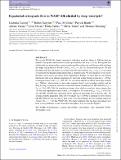Equatorial anti-rotating day side wind flow in WASP-43b elicited by deep wind jets?
Abstract
We present WASP-43b climate simulations with deep wind jets (down to 700 bar) that are linked to retrograde (westward) flow at the equatorial day side for p < 0.1 bar. Retrograde flow inhibits efficient eastward heat transport and naturally explains the small hotspot shift and large day-night-side gradient of WASP-43b (Porb = Prot = 0.8135 d) observed with Spitzer. We find that deep wind jets are mainly associated with very fast rotations (Prot = Porb ≤ 1.5 d) which correspond to the Rhines length smaller than 2 planetary radii. We also diagnose wave activity that likely gives rise to deviations from superrotation. Further, we show that we can achieve full steady state in our climate simulations by imposing a deep forcing regime for p > 10 bar: convergence time-scale τconv = 106–108 s to a common adiabat, as well as linear drag at depth (p ≥ 200 bar), which mimics to first-order magnetic drag. Lower boundary stability and the deep forcing assumptions were also tested with climate simulations for HD 209458b (Porb = Prot = 3.5 d). HD 209458b simulations always show shallow wind jets (never deeper than 100 bar) and unperturbed superrotation. If we impose a fast rotation (Porb = Prot = 0.8135 d), also the HD 209458b-like simulation shows equatorial retrograde flow at the day side. We conclude that the placement of the lower boundary at p = 200 bar is justified for slow rotators like HD 209458b, but we suggest that it has to be placed deeper for fast-rotating, dense hot Jupiters (Porb ≤ 1.5 d) like WASP-43b. Our study highlights that the deep atmosphere may have a strong influence on the observable atmospheric flow in some hot Jupiters.
Citation
Carone , L , Baeyens , R , Mollière , P , Barth , P , Vazan , A , Decin , L , Sarkis , P , Venot , O & Henning , T 2020 , ' Equatorial anti-rotating day side wind flow in WASP-43b elicited by deep wind jets? ' , Monthly Notices of the Royal Astronomical Society , vol. 496 , no. 3 , pp. 3582–3614 . https://doi.org/10.1093/mnras/staa1733
Publication
Monthly Notices of the Royal Astronomical Society
Status
Peer reviewed
ISSN
0035-8711Type
Journal article
Description
Funding: LC acknowledges funding by DLR grant 50OR1804. RB is PhD fellow of the Research Foundation – Flanders (FWO). LD acknowledges support from the ERC consolidator grant 646758 AEROSOL and the FWO Research Project grant G086217N. OV thanks the CNRS/INSU Programme National de Planétologie (PNP) and CNES for funding support. PM acknowledges support from the European Research Council under the European Union’s Horizon 2020 research and innovation programme under grant agreement 6945713. PS acknowledges the support from the Swiss National Science Foundation under grant BSSGI0155816 ‘PlanetsInTime’. Parts of this work have been carried out within the framework of the NCCR PlanetS supported by the Swiss National Science Foundation.Collections
Items in the St Andrews Research Repository are protected by copyright, with all rights reserved, unless otherwise indicated.

